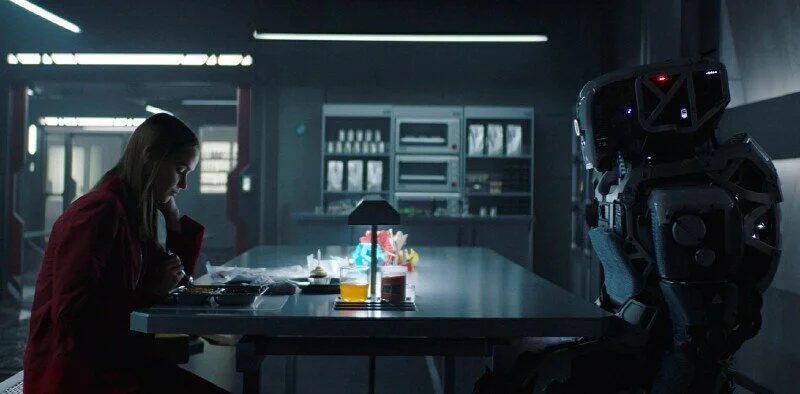I Am Mother
Words by Will Sikich
Grant Sputore’s I Am Mother (2019) explores motherhood by way of the robot apocalypse. It explores the truth about maternity and abuse in the cold brutality of Armageddon, bending the darkness of its genre to accommodate a more commonplace theme. I Am Mother depicts the birth and growth of a woman raised by a robot called Mother (voice by Rose Byrne). The woman (Clara Rugaard), referred to only as Daughter by her artificial parent, spends her days in a sleek bunker of chrome walls and garish lighting. She trusts Mother implicitly and values the robot as her only guide and companion in their lonely subterranea. That is until the arrival of a woman from the outside (Hilary Swank) threatens this bond. The woman tells Daughter not to trust her mother, insisting that the world beyond the bunker is crawling with murderous androids that look exactly like her. The seeds of mistrust sewn, Daughter begins a quest for the truth that results in a series of horrific discoveries about her mother’s true nature. Sputore delivers this story to us with stunning cinematography, employing color and mood to get at his deeper motifs.
Most of the film takes place in one of two dreary locations: the steely halls of the bunker and the smoggy wastelands of the world above. This makes Daughter’s almost invariably red clothing a powerful point of interest, reminiscent of red’s significance in Her (2013). Daughter pads through the bleak vistas of science-fiction apocalypse—a cardinal in the snow—creating a beautiful contrast that forces our eyes on her from the beginning. She stands out from her surroundings, causing us to recognize her as special in some way, or at least out of place. This echoes statements made in the rest of the film, as we discover Mother’s plans for her only daughter.
As Daughter gets to know their human guest, she becomes more aware of Mother’s habit of lying and keeping secrets. The woman tells her stories about friends and family waiting for her back at her camp, and Daughter listens hungrily. The woman also cautions her against trusting Mother, encouraging her to investigate anything Mother claims to be true. Following this advice, Daughter discovers Mother’s role as the mind behind the monstrous robots outside, along with her history of incinerating the imperfect children that came before Daughter. She decides to accompany the woman back to her home and leave Mother behind forever. This involves leaving behind her newborn brother, something Daughter immediately regrets.
At the woman’s home, she learns that the woman, too, lied to her; all of the people she told Daughter about are long dead. Once again, Daughter finds herself bitten by the selfish deceit of an unworthy mother figure. She decides to return to the bunker and rescue her brother, where she ultimately convinces Mother to replace her as the new mother of mankind. In this conclusion, though, we encounter more deceit. Sputore implies that this may have been Mother’s plan from the start, leaving us to wonder about the truth to anything we’ve seen thus far.
Regardless, as it served us in Her, the color red bleeds through the obscurity to direct our attention to what matters. We’ve known to look closely at Daughter since the beginning, and I Am Mother’s cliffhanging final scene gives direction to this raw intuition: Daughter is the conceptual speaker of the title’s declaration, I Am Mother—not either of her inadequate maternal figures. Through all the schemes and manipulations, Daughter is the one left with the power and responsibility to deal with the aftermath of her mother’s abuse. Whether or not she will rise above Mother’s twisted purpose is up to the imagination of the viewer. Sputore doesn’t care, so long as we realize the core truth of I Am Mother: nothing impacts identity like the love and abuse of a mother.



